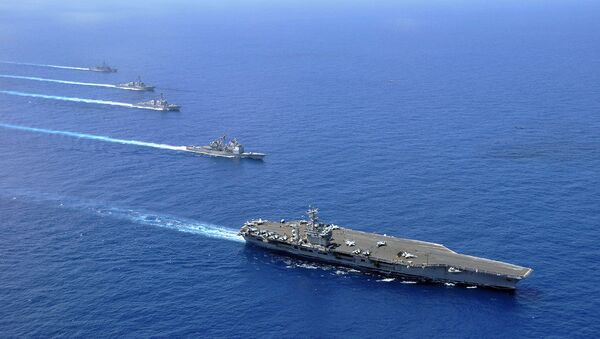Wang Guanglin from the Shanghai Institute of Foreign Languages thinks that this initiative is directed against China.
On 30 July, Maris Payne didn’t tell Sky News any details of the strengthening of the US military presence in Australia. However, a little more than a month ago, the Australian Broadcasting Company reported about the supposed construction of a new deep-water port at Glyde Point, in the north of the country, capable of receiving large US military landing ships.
If we are talking about the same naval project, then, apparently, the US wants to develop its military infrastructure 40 kilometres away from Darwin, where it already has a naval base. The base is used for the entry of warships as well as the rotational deployment of about 2,500 marine troops. Meanwhile, according to Australian media reports, the new port will be more hidden and less congested, in order to accommodate allied ships and marines.
RISS expert Vladimir Yevseyev said that the area is convenient for the US because it’s significantly closer to potential regional "hot spots" than the mainland United States. The additional infrastructure in Australia will increase the security of US military units as well as reduce their vulnerability to a potential adversary. The expert pointed out that providing greater comfort for the US Marine Corps means that the infrastructure can be used both for an acclimatisation period and for additional training before deployment in Southeast Asia.
"Creating a base in Australia near the port of Darwin will allow the US military to get an opportunity for faster relocation to Southeast Asia, if necessary. This won’t be due to the protection of Australia, but the possibility of deployment to nearby regions. Thus, Australia can actually be drawn into a conflict with China via unfavourable conditions," he said.
China's Lanqiao Company leases Port Darwin. The company has a 99-year lease, which greatly annoys the United States. Possibly, this could be one of the incentives for deploying additional military infrastructure in this particular area.
According to Wang Guanglin, the newest chapter in strengthening the US-Australia military alliance is directed against China.
"First of all, strengthening US military infrastructure in Australia should help strengthen the traditional American-Australian relations. Australia explains the maintaining and strengthening of its credibility by citing close ties with the United States. At the same time, the US is counting on Australia to secure its global interests, especially in the Asia-Pacific Region. However, I believe that the actions of the US and Australia are aimed at China. With the rise of China and the strengthening of its influence, especially after the announcement of the building of the city of Sansha and an air-strip in the South China Sea, the United States believes that all this represents a threat to their traditional interests in the region. So in fact, the subtext of the US-Australian alliance is to restrain China."
US Secretary of State Mike Pompeo is expected to discuss the issue of ensuring freedom of navigation in the South China Sea with Chinese Foreign Minister Wang Yi on Thursday, 1 August. Top diplomats have arrived in Bangkok to participate in a series of events involving ASEAN and the association’s dialogue partner. According to the United States, the strengthening of its military presence in the region, particularly the increased number of warships near disputed territories, is due to the need to balance China’s naval activities. China rejects such a reaction to the protection of the sovereignty of their territories. The parties’ military-political confrontation in the region remains at the same level, despite the trend of reducing tension in the South China Sea region.
The US Congressional endorsement of the allocation of $211.5 million for the construction of additional military infrastructure in Australia is likely to trigger a new round of military confrontation in the region. Moreover, the US is using Australia to unleash the Indo-Pacific strategy. At the same time, few people doubt that it’s aimed to contain China, both militarily and politically.




